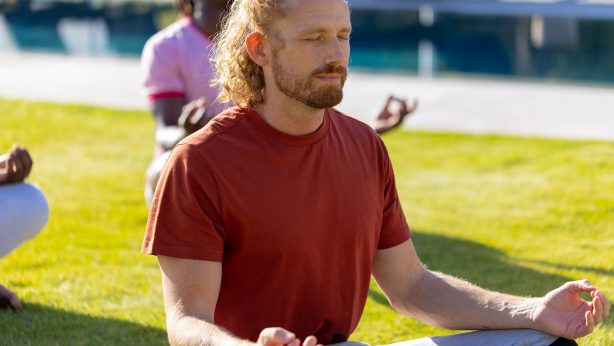
The wonderful art of yoga and meditation is considered to be one of the most serene and transformative journeys of self-discovery and holistic wellness. People are embracing the yogic path with dedication and integrity intending to make a positive impact on their overall health and well-being. Yoga and meditation are powerful practices that empower and promote physical, emotional, and mental well-being. Yoga combines movement, breathwork, and mindfulness to improve flexibility, strength, and balance, while also reducing stress and enhancing relaxation.
There are many holistic benefits attached to yoga practices that include, stress-relief, increased self-awareness, improved concentration, and a sense of inner calm. It is significant in dealing with chronic ailments and provides sustainable, long-term relief to people. Becoming a certified yoga teacher is a rewarding attainment that requires dedication, passion, and commitment to practice. If you are looking for tips on how to become a certified yoga teacher, you must read this to get the complete information.
- Deepen your knowledge: Before pursuing any training and course for yoga, one must immerse in the practice of yoga themselves. You must explore different styles and deepen your understanding of yoga philosophy, various asanas, breathing work, and meditation. One must understand the roles and responsibilities of a yoga teacher in depth before practicing it professionally.
- Research Yoga Teacher Training Programs: There are different types of Yoga Teacher Training (YTT) programs for people and their various requirements. You must search and find the one that aligns with your goals, schedule, and budget. Consider factors such as the program’s curriculum, teaching faculty, location, duration, and certification credentials.
- Choose Your Yoga Style: Out of various styles of yoga, decide which style(s) of yoga you want to specialize in, such as Hatha, Vinyasa, Ashtanga, Yin, or Kundalini. Choose a YTT program that offers training in your preferred style(s) or explore programs that provide a well-rounded curriculum encompassing multiple styles.
- Attend A Yoga Teacher Training Program: To get the right knowledge and techniques, one must consider an apt YTT program. These types of Yoga Teacher Training programs typically consist of immersive training modules covering yoga philosophy, anatomy, teaching methodology, practicum, and ethics.
- Dig Deep In The Curriculum: Dedicate yourself to learning and self-exploration. Participate actively in lectures, workshops, practical sessions, and teaching practicums to gain a comprehensive understanding of yoga theory and teaching techniques.
- Cultivate Self-Awareness: Yoga teacher training is not just about learning to teach yoga; it’s also a journey of self-discovery and personal growth. Cultivate self-awareness, compassion, and mindfulness through introspection, meditation, and reflection on your own practice and teaching journey.
- Continue Your Journey: Yoga practice is a continuous process and has immense scope in terms of learning. A person who aspires to become a yoga teacher must stay curious, continue learning, and deepen their knowledge through workshops, advanced training, mentorship, and self-study. One needs to look out for periodic renewable yoga alliances.
In today’s fast-paced world of opportunities and survival, people find it difficult to maintain a balance between their holistic wellness and competitive lifestyle. They struggle to cultivate healthier and mindful practices amidst daily hustle-bustle. Thus, they look for practices that are sustainable, and healthy and help in attaining overall wellness. Yoga is one of those practices. Becoming a yoga teacher offers numerous benefits both personally and professionally. Let’s look at some of the benefits of pursuing a career as a yoga teacher.
- Physical Health: Yoga offers a multitude of physical benefits, including improved flexibility, strength, and posture, as well as reduced risk of injury and chronic pain. The role of a yoga teacher is to promote physical well-being and encourage students to prioritize their health through regular practice and also look after their physical well-being.
- Mental Well-being: Yoga is not only a physical practice but also a mental and emotional one. Through mindfulness, breathwork, and meditation, yoga cultivates mental clarity, emotional resilience, and a sense of inner peace. As a yoga teacher, you can guide students on a journey of self-discovery and self-care, supporting their mental well-being in today’s hectic world.
- Community Building: People are turning towards yoga for various benefits and positive outcomes. Yoga classes serve as a gathering place for like-minded individuals seeking connection and community. By teaching yoga, you create a supportive and inclusive environment where people can come together to practice, share, and support one another, fostering a sense of belonging and camaraderie.
- Career Flexibility: With the rise of online and virtual yoga platforms, there are more opportunities than ever to teach yoga remotely. This flexibility allows you to create a schedule that suits your lifestyle, whether you’re balancing teaching with another job, raising a family, or pursuing other interests.
- Personal Growth: Teaching yoga is a journey of continual learning and growth, both as a practitioner and as a teacher. It challenges you to deepen your understanding of yoga philosophy, refine your teaching skills, and cultivate qualities such as patience, compassion, and authenticity.
- Contribution to Society: By becoming a yoga teacher, you have the recognition of making a positive impact on the lives of others. You empower individuals to take control of their health and well-being, inspire them to live mindfully and authentically and contribute to the greater good of society as a whole.
These steps and practices stated here will help you embrace the yogic path with ease and determination. Yoga teacher training programs welcome individuals from diverse backgrounds and experiences who share a passion for yoga and a desire to deepen their practice. Here are some examples of who can become yoga teachers:
- Yoga Enthusiasts: Those who have a dedicated yoga practice and a genuine love for the practice often pursue yoga teacher training to deepen their understanding and share their passion with others.
- Fitness Instructors: Individuals with a background in fitness, such as personal trainers, group fitness instructors, or dance instructors, may choose to expand their skill set by becoming certified yoga teachers.
- Health and Wellness Professionals: Nurses, therapists, counselors, and other health and wellness professionals may incorporate yoga teaching into their practice to offer holistic and complementary services to their clients.
- Career Changers: People seeking a career change or transition may discover a calling in yoga teaching, drawn by the opportunity to inspire others, promote well-being, and make a positive impact through teaching.
- Retirees: Retirees with a lifelong passion for yoga may pursue teacher training as a way to continue their personal growth, stay active, and share their wisdom and experience with others in their community.
Read More : How to become a certified Health and Wellness Coach
Overall, anyone with a sincere interest in yoga, a commitment to personal growth, and a willingness to learn and share can embark on the journey to become a certified yoga teacher. You can also embark on a fulfilling career as a certified yoga teacher, sharing your gift with others and making a positive impact on the world.


